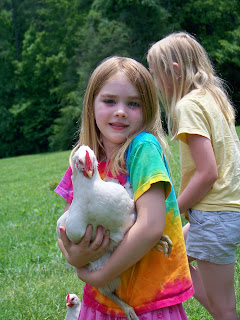It's been a scattered kind of week. I thought this entire post would be about our chickens but some pressing issues regarding our future use of our land have come up today and that's in the front of my mind.
 |
| Cockerel roosting in one of our fig trees |
They adore the fig tree - it must have the most delicious bugs living underneath it. Also, the average temperature here has been around 94 for almost a month now and the fig gives tremendous shade. It's probably a good 15 degrees cooler under it. I've taken to calling this particular fig tree the Chicken's Summer House.
You may remember that these chickens are part of a recovery project by the American Livestock Breed Conservancy. We're raising these endangered heritage chickens for eggs and meat, but also to help with the repopulating of the Java, a beautiful bird that was once the most popular American chicken. Our friends from the ALBC came out to the farm a few days ago to do a first evaluation of our flock. The plan is to identify the very best birds for breeding and then swap some birds around between the grow out farms so that the best of the genetic line will continue and the number of Javas will grow. Imperfect birds will be used to provide eggs for consumption and meat.
 |
| Separating hens from roosters |
 |
| Checking the spine |
 |
| Tagging the wing of a great bird |
 |
| Blue tag on wing of impressive rooster |
 |
| Evaluating breast meat "fleshiness" |
 |
| Assistants helping out |
All in all, we tagged two of the eight roosters and six of the fourteen hens. These eight birds will be evaluated again around 20 weeks of age to see which ones will be best for breeding. Some of our best birds will leave us to go to another grow out farm and we will receive other birds in order to keep the genetic lines mixed.
In addition to evaluating our birds, we talked briefly about what animal we should add to our farm next. We want to continue with heritage breeds and the ALBC has kindly agreed to help us evaluate our land and give us advice on potential ways to lay it out so that we will eventually be able to have all the livestock we wish to have as well has maximizing our cropland.
And that's what's bugging me today. A while back, I told you about how Evan had an intestinal parasite and we initially thought our well may have become contaminated. The well was fine - Evan just wasn't washing his hands well enough (a common occurrence for a 4 year old boy, I suppose). But, in our inspection of the well, we did find out that our well is extremely shallow - only 75ft. Most wells today are dug to a depth of 200 feet or more. And, while our water is sufficient for our family's needs, it is likely not going to be enough to grow our farm. Crops have to be irrigated and animals watered and it takes a LOT of water. So, we've been advised to dig a new well. This is not an inexpensive proposition, however, and I'm not sure about it.
Brendan has always wanted to get off the grid as much as possible. I'm all for it in theory but the reality is I like the conveniences of being connected to the grid. It would take a large number of solar panels to power everything in our house and the only place we have to put them is in the field which would take up room we'd like to have for livestock. But, I've been thinking a lot today about installing a cistern as a potential answer to our problem. A cistern is essentially the same thing as having rain barrels, just on a larger scale. We could get a 1500 gallon cistern to collect rainwater and use that for the crops and animals and only rely on the existing well for the needs of the house. We might still eventually have to dig a new well, but we could put it off and be more green in the process. What do you think?

No comments:
Post a Comment